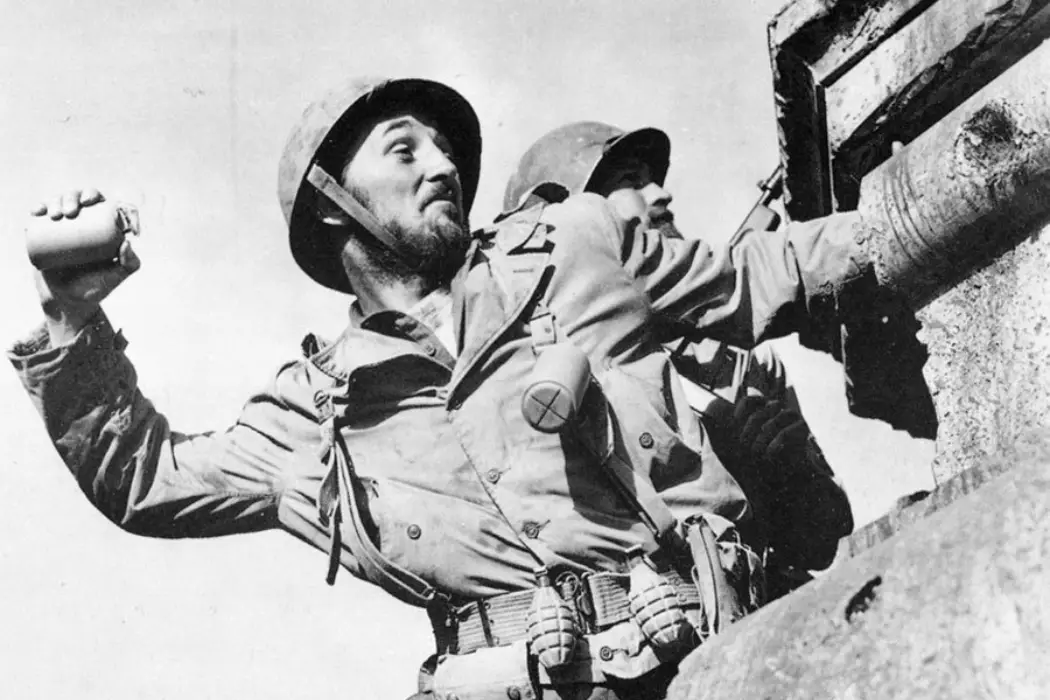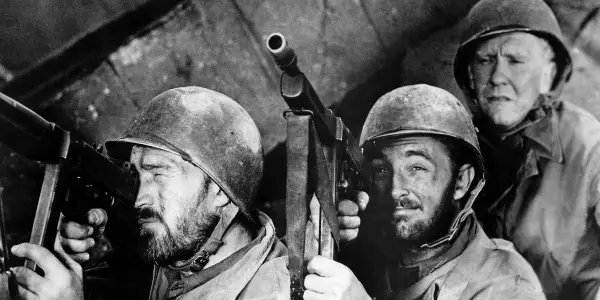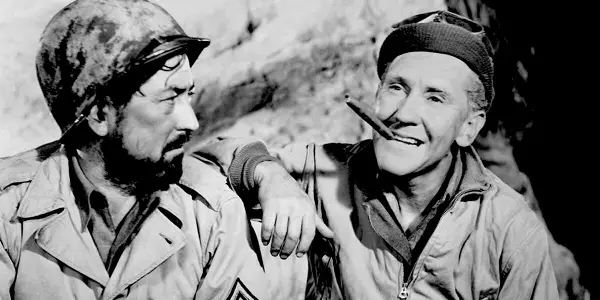THE STORY OF G.I. JOE: The Stunning New Restoration Celebrates The Work Of War Correspondent Ernie Pyle

Tynan loves nagging all his friends to watch classic movies…
I recall hearing how so many war movies are inherently phony because they occur in war rooms with generals standing around moving pins on a map like chess pieces. Whereas war is about the soldiers and boots on the ground.
They are the ones forced to carry out orders as they struggle to live through another day in the face of impending death. They are the ones who realize how cruel and merciless war is. Most anything else feels disingenuous to the experience.
Based on Ernie Pyle‘s WWII dispatches and directed by William A. Wellman, The Story of G.I Joe, is a testament to the foot soldier. Pyle earned his reputation honestly by getting to know the common man. In its most frank depictions, war shows us humanity in the face of the greatest tribulations.
Both men knew this intuitively from firsthand experience. Pyle‘s connection is obvious because he just as easily could have bunkered down at military headquarters with the top brass and gleaned updates while maintaining his civilian comforts. However, he got the news the hard way and did a public service for all the families reading back on the Homefront.
Wellman for his part had flown planes in WWI earning his lifelong nickname “Wild Bill” for his exploits. He also took it upon himself to surround his stable of actors with real battle-tested men who had served overseas in the very conflicts the film was portraying; they would be shipped out to Okinawa to fight the Japanese shortly after filming.
Not only Pyle‘s words but his fingerprints were over the movie. He purportedly earmarked Burgess Meredith to play him and shared a friendly camaraderie with Wellman. Sadly Pyle would die on assignment in Okinawa. Though it is a moving testament to how ensconced he was with the military. He was one of their own and they gladly celebrated him.
The Talent and The Story
Robert Mitchum cut his teeth on some Hopalong Cassidy serials and earnest propaganda movies from the war years. The Story of G.I. Joe was his first prominent role and the only film that ever netted him an Oscar nomination if you can believe it.
Mitchum built a reputation at RKO being laconic, sometimes surly, and a man’s man. In G.I. Joe he’s an emblem of American masculinity as Lt. Bill Walker; he leads his company with a steady authority. There’s both gumption and a salt-of-the-earth sincerity to him.

That’s the key with Mitchum. You always believe what he’s saying, and it’s no different here whether he orders an AWOL soldier to dig latrines ’til kingdom comes or he has the unenviable task of notifying parents back home about their fallen loved ones. He’s the rock of the movie.
Some wonderful contemporary war films like Sahara or Objective, Burma! have a more obvious structure. There is a mission or an outcome to be achieved. G.I. Joe feels looser with the inevitable march of war playing as the backdrop to these keenly observed character studies.
The pristine print brings history alive in a way that is immersive and tactile. The close-ups of the individual faces are especially apparent in the new restoration. You can pick your favorite members of the company and follow their progress.
The loping Pvt. Murphy (John R. Reilly) whose feet always have a habit of sticking out of the end of his tent. There’s the girl-crazy Donardo played by Wally Cassell who feels stifled by the war, constantly dreaming of some female company (Carole Landis would do nicely).
Freddie Steele (Hail The Conquering Hero) is another standout as the grizzled Sgt. Warnicke. He feels physically indestructible even as his mind comes under more and more duress.
Meredith‘s amiable Pyle becomes the story’s conduit as he falls in with the callow C company of the 18th infantry. They pick up a stray dog who becomes their mascot. Artie Shaw plays over the radio giving the semblance of home though he comes in the guise of Axis Sally’s propaganda. Mail call is such a joyous occasion; Warnicke even receives a recording with his baby son’s voice on it. This token becomes a symbol of everything these boys are giving up by not being back home.

It becomes second nature that they have a shared camaraderie through their experiences; it galvanizes them like few things can. A perfect example is when Walker tells his buddy, “Let’s go to church, Wernicke.” They proceed to tag team taking out the German snipers in the belfry. The move may feel familiar to anyone who’s ever seen Saving Private Ryan.
The enemy is mostly faceless because they are hardly the focal point. It is a story about how war affects the common American soldier and also what he must go through. Each of these men we meet function as a unit, but they represent different sides of the same man: G.I. Joe.
At times, it feels like a wartime hangout movie from the comfort of our couches. That’s the service Pyle and Wellman extend to us: Transporting us there so we’re present for the mundane moments as well as the chaos. In this regard, G.I. Joe presages some wonderfully textured ensemble pieces like A Walk in The Sun, Paisan, or Battleground.
The lulls feel equally important if not more so because they capture the vicissitudes of a foot soldier’s life. Not every day is hellfire. Though it’s hardly a lark. In one aside a soldier says, “When this war is over I’m going to buy myself a map and find out where I’ve been.”
There are moments of joy too. A wedding is something decent for all the boys to rally around and Ernie gives away the bride, Elizabeth, played by Wellman‘s own bride Dorothy Coonan Wellman. They fashion a bridal suite out of an ambulance and then linger there for a moment.
Not like peeping toms. Those two lovebirds carry with them all their hopes and aspirations for a better life. It is a subtle reminder of why they’re sacrificing so much without giving us a lot of soppy propaganda.

Along with Wernicke’s search for a Victrola, the other stirring semiotic example is one man’s insurance policy. Pvt. Mew (William Murphy) has no next of kin and so he keeps on reallocating the money to his buddies with each new dead comrade in arms. Crossing out names and adding new ones.
It’s these notes that feel pure and heartbreaking. The boys share the most dismal Christmas imaginable even as Walker tries to rustle them up so cheer. And amid all the insanity they’ve experienced, news of Pyle‘s Pulitzer Prize feels like an absurd pile of crock. It puts everything in perspective and what a gift it is that they can laugh about it together.
The movie ends with a gutting tragedy and it’s only tragic because we have been through so much with these men. It’s easy to understand how you would grow so close in a foxhole. Ernie loved and admired these men and the feelings were mutual.
Conclusion: The Story of G.I. Joe
I first became aware of Ernie Pyle through the homages of cartoonist Charles Schulz in his comic strip Peanuts. They feel like strange bedfellows, but before he was ever the world-renowned creator of Charlie Brown and Snoopy, “Sparky” was also a soldier in Europe. Pyle was a beloved figure for him too.
Watching a movie like The Story of G.I. Joe, it doesn’t seem like a far stretch to understand the significance of Ernie Pyle. He was, like Bill Mauldin (who was also featured in Peanuts), a chronicler of the everyman keeping their hopes and aspirations alive. Perhaps they knew as long as their lives were dignified with grace and humor, there were still things in this world worth fighting for.
Pyle might represent a forgotten footnote in World War II history for some, but the loving new print from Ignite Films and The Film Foundation does Yeoman’s work in bringing his story back to the fore with stunning perspicuity.
Among a handful of extras, the most engaging is an interview with Bill Wellman Jr. full of personal anecdotes and then there’s a full commentary by historian Alan K. Rode. For any avowed Robert Mitchum or William Wellman fans who have not checked it off their docket already, it’s well worth consideration.
Does content like this matter to you?
Become a Member and support film journalism. Unlock access to all of Film Inquiry`s great articles. Join a community of like-minded readers who are passionate about cinema - get access to our private members Network, give back to independent filmmakers, and more.
Tynan loves nagging all his friends to watch classic movies with him. Follow his frequent musings at Film Inquiry and on his blog 4 Star Films. Soli Deo Gloria.













